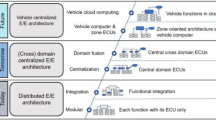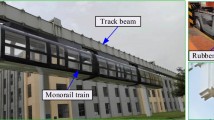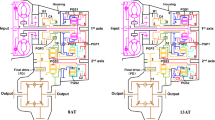Abstract
The vehicle longitudinal dynamics estimates the requested power to attend a specific route by means of the motion resistance forces such as aerodynamic drag and rolling resistance as well as factors related to the road grade and driver behavior. In high speeds and accelerations stretches proposed by the US06 standard, the conventional 1.0 l Brazilian vehicles do not achieve the required velocity. One alternative to increase the vehicle speed is to use a combination of gear shifting strategies because it changes the engine operating point. The hybrid electric vehicles (HEVs) are also an alternative to increase the vehicle performance and reduce the fuel consumption, maintaining the safety and trustworthiness of the conventional vehicles. The aim of this paper is to compare a conventional vehicle with a parallel HEV in terms of dynamic behavior and also to analyze the influence of the gear shifting tactics in both vehicle configurations. The analyses were performed through co-simulation between the multibody dynamics software Adams™ and Matlab/Simulink™ where the power demand was defined based on the motion resistance forces equations.



















Similar content being viewed by others
Abbreviations
- A :
-
Vehicle frontal area (m2)
- a :
-
Acceleration (m/s2)
- \(C_{\rm d}\) :
-
Drag coefficient
- \(C_{\rm e}\) :
-
Specific fuel consumption (g/(k Wh))
- \(C_l\) :
-
Volumetric fuel consumption (l/h)
- \({\rm CR}_n\) :
-
Total charge removed (Ah)
- D :
-
Damping constant (Ns/m)
- \(D_{\rm a}\) :
-
Aerodynamic drag (N)
- DC:
-
Direct current
- DoD:
-
Depth of discharge (%)
- \(E_{\rm a}\) :
-
Back EMF (V)
- ECU:
-
Engine control unit
- EM:
-
Electric motor
- F :
-
Traction force (N)
- \(F_n\) :
-
Traction force (N)
- HEV:
-
Hybrid electric vehicle
- ICE:
-
Internal combustion engine
- I :
-
Inertia (kg m2)
- \(I_{\rm a}\) :
-
Armature current (A)
- \(I_{\rm ref}\) :
-
Reference current (A)
- k :
-
Coefficient of Peukert
- \(K_{\rm t}\) :
-
Torque constant (N m/A)
- \(K_{\rm e}\) :
-
Back EMF constant (V s/rad)
- L :
-
Electrical inductance (H)
- M :
-
Vehicle mass (kg)
- N :
-
Transmission ratio
- n :
-
Number of clutch faces
- \(P_b\) :
-
Battery power demand (W)
- Pot :
-
Battery available power (W)
- PI:
-
Proportional and integral
- PMS:
-
Power management system
- \(t_r\) :
-
Tire external radius (m)
- R :
-
Correlation coefficient
- r :
-
Electrical resistance (\(\Omega\))
- \(R_o\) :
-
Clutch external radius (m)
- \(R_i\) :
-
Clutch internal radius (m)
- \(R_x\) :
-
Rolling resistance (N)
- T :
-
Torque (Nm)
- Vel :
-
Vehicle speed (m/s)
- V :
-
Electrical voltage (V)
- \(V_{\rm t}\) :
-
Armature voltage (V)
- \(\eta\) :
-
Efficiency
- \(\rho\) :
-
Air density (kg/m\(^3\))
- \(\rho _{\rm f}\) :
-
Fuel density (kg/m\(^3\))
- \(\omega\) :
-
Angular velocity (rad/s)
- \(\mu\) :
-
Friction coefficient
- a :
-
Armature
- lo :
-
Load
- cl :
-
Clutch
- d :
-
Differential
- e :
-
Engine
- el :
-
Electrical
- EM :
-
Electric motor
- gd :
-
Differential + gearbox
- g :
-
Gearbox
- p :
-
Powertrain
- w :
-
Wheels and tires
- x :
-
Longitudinal direction
References
General Motors Brazil (2013) Owner Manual Chevrolet Celta 2013. General Motors Brazil Ltda
Al-Hammouri A, Liberatore V, Al-Omari H, Al-Qudah Z, Branicky MS, Agrawal D (2007) A co-simulation platform for actuator networks. In: Proceedings of the 5th international conference on embedded networked sensor systems. ACM, pp 383–384
Barlow TJ, Latham S, McCrae I, Boulter P, et al (2009) A reference book of driving cycles for use in the measurement of road vehicle emissions, TRL Limited, Technical Report
Brezina T, Hadas Z, Vetiska J (2011) Using of co-simulation adams-simulink for development of mechatronic systems. In: MECHATRONIKA, 2011 14th international symposium. IEEE, pp 59–64
Çağatay Bayindir K, Gözüküçük MA, Teke A (2011) A comprehensive overview of hybrid electric vehicle: powertrain configurations, powertrain control techniques and electronic control units. Energy Conv Manag 52(2):1305–1313
Cipek M, Pavković D, Petrić J (2013) A control-oriented simulation model of a power-split hybrid electric vehicle. Appl Energy 101:121–133
Corrêa FC, Eckert JJ, Silva LC, Santiciolli FM, Dedini FG (2014) Application of fuzzy logic for power management in hybrid vehicles. Mecánica Computacional 33(39):2445–2455
Crolla DA, Cao D (2012) The impact of hybrid and electric powertrains on vehicle dynamics, control systems and energy regeneration. Veh Syst Dyn 50(sup1):95–109
Davis SC, Diegel SW, Boundy RG (2003) Transportation energy data book: edition 23. Technical report, Department of Energy, United States
Dextreit C, Kolmanovsky IV (2014) Game theory controller for hybrid electric vehicles. Control Syst Technol IEEE Trans 22(2):652–663
Eckert JJ, Corrêa FC, Santiciolli FM, Costa EdS, Dionísio HJ, Dedini FG (2015) Vehicle gear shifting strategy optimization with respect to performance and fuel consumption. An International Journal of Mechanics Based Design of Structures and Machines
Fuhs A (2008) Hybrid vehicles: and the future of personal transportation. CRC Press
Gillespie TD (1992) Fundamentals of vehicle dynamics. Society of Automotive Engineering Inc.
Guan T, Frey CW (2012) Fuel efficiency driver assistance system for manufacturer independent solutions. In: 2012 15th international IEEE conference on intelligent transportation systems (ITSC). IEEE, pp 212–217
Hines K, Borriello G (1997) Dynamic communication models in embedded system co-simulation. In: Proceedings of the 34th annual design automation conference. ACM, pp 395–400
Kahlbau S, Bestle D (2013) Optimal shift control for automatic transmission. Mech Based Des Struct Mach 41(3):259–273
Kim D, Hwang S, Kim H (2008) Vehicle stability enhancement of four-wheel-drive hybrid electric vehicle using rear motor control. Veh Technol IEEE Trans 57(2):727–735
Kliauzovich S (2007) Analysis of control systems for vehicle hybrid powertrains. Transport 22(2):105–110
Ko J, Ko S, Son H, Yoo B, Cheon J, Kim H (2015) Development of brake system and regenerative braking cooperative control algorithm for automatic-transmission-based hybrid electric vehicles. Veh Technol IEEE Trans 64(2):431–440
Kulkarni M, Shim T, Zhang Y (2007) Shift dynamics and control of dual-clutch transmissions. Mech Mach Theory 42(2):168–182
Li Q, Chen W, Li Y, Liu S, Huang J (2012) Energy management strategy for fuel cell/battery/ultracapacitor hybrid vehicle based on fuzzy logic. Int J Electr Power Energy Syst 43(1):514–525
Navidi WC (2008) Statistics for engineers and scientists. McGraw-Hill Higher Education
Nüesch T, Elbert P, Flankl M, Onder C, Guzzella L (2014) Convex optimization for the energy management of hybrid electric vehicles considering engine start and gearshift costs. Energies 7(2):834–856
Raggi MVK, Sodré JR (2014) Numerical simulation of carbon monoxide emissions from spark ignition engines. J Braz Soc Mech Sci Eng 36(1):37–43
Reyss O, Duc G, Pognant-Gros P, Sandou G (2009) Multivariable torque tracking control for e-ivt hybrid powertrain. Int J Syst Sci 40(11):1181–1195
Rizoulis D, Burl J, Beard J (2001) Control strategies for a series-parallel hybrid electric vehicle. Technical report, SAE Technical Paper
Song M, Oh J, Kim J, Kim Y, Yi J, Kim Y, Kim H (2014) Development of an electric oil pump control algorithm for an automatic-transmission-based hybrid electric vehicle considering the gear shift characteristics. Proc Inst Mech Eng Part D: J Automob Eng 228(1):21–36
Vagg C, Brace CJ, Wijetunge R, Akehurst S, Ash L (2012) Development of a new method to assess fuel saving using gear shift indicators. Proc Inst Mech Eng Part D: J Automob Eng 226(12):1630–1639
Waltermann P (1996) Modelling and control of the longitudinal and lateral dynamics of a series hybrid vehicle. In: Proceedings of the 1996 IEEE international conference on control applications. IEEE, pp 191–198
Wei-bo Y, Ding-xuan Z, Nimg C (2004) Study on fuzzy gearshift tactics in automatic gearshift control system of technical vehicles. In: Industrial Electronics Society, 2004. IECON 2004. 30th annual conference of IEEE, vol 1. IEEE, pp 425–429
Xi L, Xiangyang X, Yanfang L (2009) Simulation of gear-shift algorithm for automatic transmission based on matlab. In: WRI World congress on software engineering, 2009. WCSE’09, vol 2. IEEE, pp 476–480
Yazdani A, Shamekhi A, Hosseini S (2014) Modeling, performance simulation and controller design for a hybrid fuel cell electric vehicle. J Braz Soc Mech Sci Eng 37(1):375–396
Yin X, Xue D, Cai Y (2007) Application of time-optimal strategy and fuzzy logic to the engine speed control during the gear-shifting process of amt. In: Fourth international conference on fuzzy systems and knowledge discovery, 2007, FSKD 2007, vol 4. IEEE, pp 468–472
Acknowledgments
This work was conducted during scholarships supported by the Brazilian Federal Agency for Support and Evaluation of Graduate Education (CAPES), National Council for Scientific and Technological Development (CNPq) and the State University of Campinas (UNICAMP).
Author information
Authors and Affiliations
Corresponding author
Additional information
Technical Editor: Marcelo A. Savi.
Rights and permissions
About this article
Cite this article
Eckert, J.J., Santiciolli, F.M., Silva, L.C.A. et al. Co-simulation to evaluate acceleration performance and fuel consumption of hybrid vehicles. J Braz. Soc. Mech. Sci. Eng. 39, 53–66 (2017). https://doi.org/10.1007/s40430-015-0484-4
Received:
Accepted:
Published:
Issue Date:
DOI: https://doi.org/10.1007/s40430-015-0484-4




